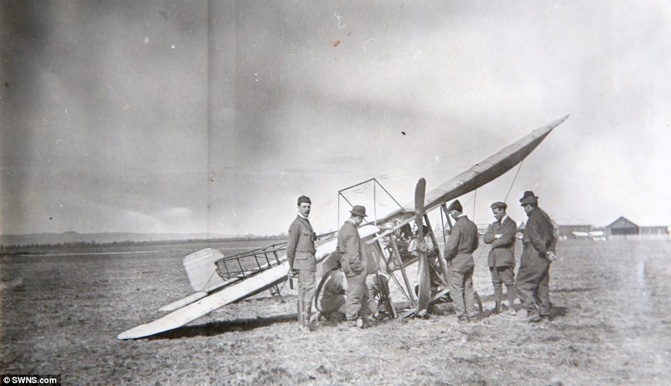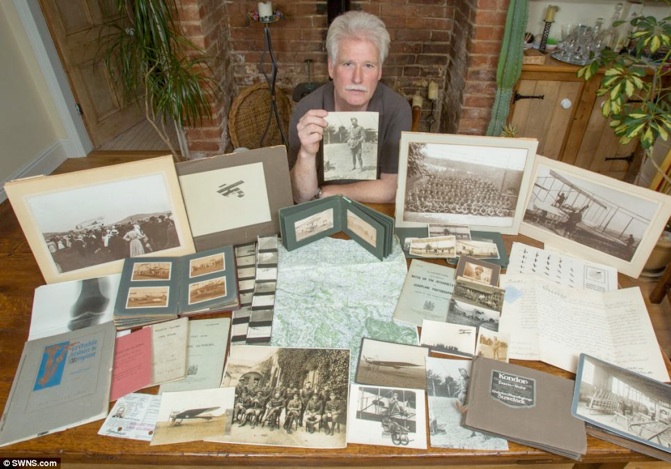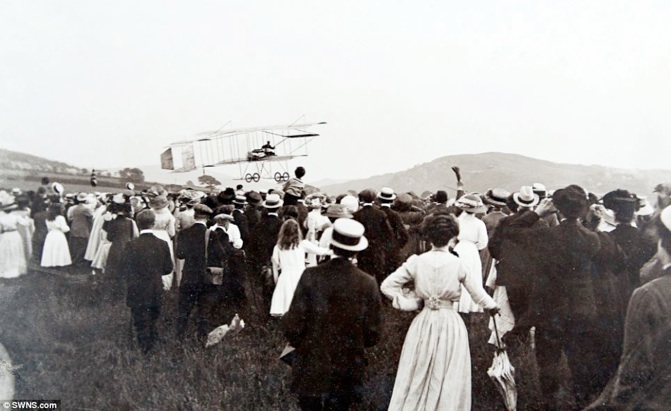Incredible story of the daredevil WW1 flying ace who coined the term 'joystick' while setting a string of records, had his war wounds x-rayed by Marie Curie (and even starred on Broadway)
-
•Major Robert Loraine earned huge fame by piloting early planes on daring missions in the first days of aviation
-
•While using his skills to help the First World War effort, he was shot down and treated by chemist Marie Curie
-
•Having set a series of flying records, Major Loraine went on to become a theatre and film actor in retirement
The death-defying bravery of a daredevil First World War pilot has been revealed after his diaries, log-books and photos were brought together in one collection.
Aviation pioneer Major Robert Loraine shot to fame as one of Britain's best-loved pilots at the beginning of last century, when he became the first person to fly across the Irish Channel and the first to land on the Isle of Wight in 1910.
He was also the first to fly in a rainstorm, when he took to the air wearing nothing more than a pair of goggles with his flying suit for protection, and sent the first ever radio message in flight.
The Oxford English dictionary at the time credited him with the first use of the word 'joystick' in 1909, which he used in his diary because of the joy he got from flying.
The dashing pilot - said to have been popular with ladies of the time - used his expert flying skills to climb the ranks of the recently-formed Royal Flying Corps in the First World War and even landed one of his planes after being shot in the neck.
He was awarded the Distinguished Service Order in 1917, but a year later his military career was brought to an end when he was shot in the leg. The x-rays of his injured limb are thought to have been carried out by Marie Curie, who had a mobile unit where he was treated.
After leaving the Flying Corps, the married father-of-three went on to star in a handful of films and Broadway shows, before he passed away in 1935, aged 59.
An enormous collection of his log books, photos, maps and newspaper cuttings - along with the x-rays taken of his leg - has now been brought together by historian Jim Hine, 60, who is planning to sell the collection for an estimated £25,000 at a book sale later this month.
Mr Hine, of Ilminster, Somerset, said: 'He was a really gung-ho character, larger than life. He really was very brave. These planes were very susceptible to engine failure and if you ditched into the sea there was no chance of getting picked up.
'He was able to get so many firsts because it was the very early days of flying. The Wright brothers were literally flying for the first time just a few years before - it was real seat of the pants stuff.'

+18
Aviation pioneer Robert Loraine standing next to a Bristol Boxkite, believed to be taken before he flew over Stonehenge making the first radio communication from the air in 1910

+18

Loraine, above, flying a plane with a gunner around the time of First World War (left). He was one the first into the air during the war after mastering flight in the Bristol Boxkite (right)

His adventures in early aircraft came with considerable dangers, and he is pictured here, wounded (far left), after a crash in a Bleriot plane

Loraine, from Cheshire, served as a volunteer in the Boer War between 1899 and 1901 before a stint on Broadway until he took up aviation in France in 1909. He is pictured here in his Farman biplane around 1910

In 1910, he piloted one of two Bristol Boxkites in British Army manoeuvres on Salisbury Plain, during which he sent the first radio message from the air in Britain while flying over Stonehenge

Loraine and his friends inspect the site of one of his many crashes in early aircraft before the start of the First World War

During the First World War, Loraine (circled) climbed the ranks of the Royal Flying Corps. His gallant efforts earned him the Military Cross for shooting down an albatross biplane in 1915 with 'conspicuous gallantry and skill'


After he was shot in the leg in 1917, these x-rays were taken of his leg and are thought to have been carried out by Marie Curie

Robert Loraine's private pilot's license from his time in the USA, dated Oct 23rd 1933. He spent time working as an actor in the US after retiring from the military. A press cutting written around his time of death in December 1935 says: 'Robert Loraine will be remembered as one of the handsomest romantic actors of the present century.'

An enormous collection of Loraine's log books, photos, aviation maps and newspaper cuttings were brought together by amateur historian Jim Hine, who is selling the documents at a book fair at Oxford Brookes University later this month


One of Loraine's more dramatic crashes is documented in a photo taken just before the First World War (left) and a caricature of Robert Loraine from 1910 (right).

Commissioning papers from King George V to Robert Loraine making him 2nd Lieutenant, dated 6th August 1914. He was awarded the Distinguished Service Order in 1917

Loraine, who was said to be very popular with the women of the time, landing his Farman aircraft at Ross-on-Sea golf course, in 1910

The collection, going on sale at a fair at Oxford Brookes University on April 26 and 27, includes photos relating to aircraft gun camera training

The archive - believed to be the biggest in the world on Loraine - includes his flight log books, the photo of the flight when he sent the first radio message and trade catalogue of the planes he bought